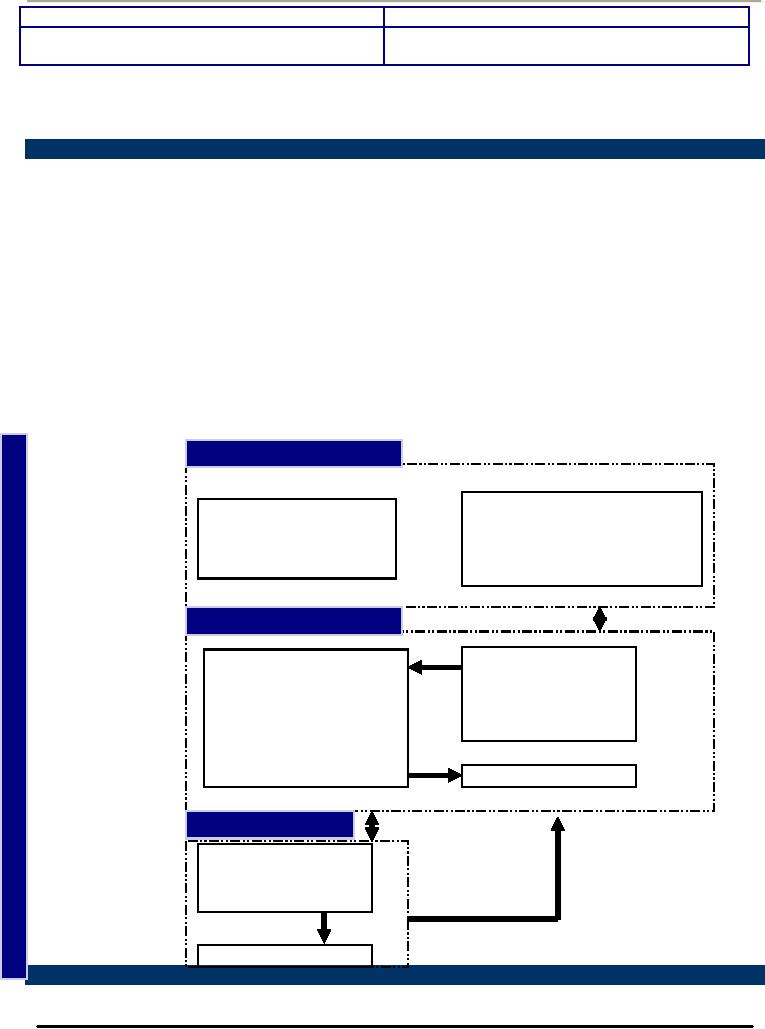 |

Consumer
Psychology (PSY -
514)
VU
Lesson
05
VALUE
AND RETENTION FOCUSED
MARKETING
AND
CONSUMER
DECISION MAKING PROCESS
OBJECTIVES:
o
Understanding
Value and Retention Focused
Marketing
Comparison
between Tradition Marketing
Concept and Value and
Retention Focused
Marketing
Consumer
Decision Making Process
What
Consumer Psychologists Do?
1.
Tradition Marketing Concept and
Value and Retention Focused
Marketing
The
Traditional Marketing
Concept
Value
and Retention Focused
Marketing
Make
only what you can
sell instead of trying
to
Use
technology that enables
customers to
sell
what you can
make
customize
what you make
DO
not focus on the product; focus on
the need
Focus
on products perceived value as well as
the
that
it satisfies
need
that it satisfies
Make
products and services that
match
Utilize
an understanding of customers needs
to
customers
needs better than competitors
develop
offerings that customers
perceive as more
offerings
valuable
than competitor's offerings
Research
consumers needs and
characteristics
Research
levels of profit associated with
various
consumers
needs and characteristics
Understand
the purchase process and
influences
Understand
consumer behavior in relation to
a
upon
consumer behavior
company's
product
Realize
that each customer
transaction is a direct
Make
each customer transaction as part of
on-
sales
going
relationship with the
customer
Segment
the market based on
customers
Use
hybrid segmentation that combines
thee
geographic,
demographic, psychological, socio-
traditional
segmentation bases with data
on
cultural,
lifestyle and product usage
related
customers'
purchase levels and patterns of
use of
characteristics
the
company's products
Target
large groups of customers
that share
Invest
in technologies that enable
you to send
common
characteristics with
messages
one-to-one
promotional messages via
digital
transmitted
through mass media
channels
Use
one way promotions whose
effectiveness is
Use
interactive communications in
which
measured
through sales data or
marketing
messages
to customers are tailored according
to
surveys
their
responses to previous
communications
Create
loyalty programs based upon the
volume
Create
customer tiers based on both
volume and
purchased
consumption
patterns
Encourage
customers to stay with the
company
Make
it very unattractive for your
customers to
and
buy more
switch
to a competitor and encourage them
to
purchase
"better" in a manner that will
raise the
company's
profitability levels
Determine
marketing budgets on the
basis of the
Base
your marketing budget on the
"lifetime
numbers
of customers you are trying
to reach
value"
of typical customers in each of
the
targeted
segments compared with
resources
needed
to acquire them as
customers
Conduct
customer satisfaction surveys
and
Conduct
customer satisfaction surveys
that
present
the results to
management
include
a component that studies the
customer's
word-
of mouth about the company, and
use the
results
immediately to enhance
customer
15

Consumer
Psychology (PSY -
514)
VU
relationships
Create
customer trust and loyalty to
the company
Create
customer intimacy bonds with
completely
and
high levels of customer
satisfaction
satisfied.
"Delighted" customers.
Source:
Joseph Wisenblit, "Beyond Marketing
Concept: From `Make Only
What You Can Sell to `Let
Customers
Customize
What you Can Make',
"The Still man School of
Business, Steon Hall
University, South Orange,
NJ.
2.
Consumer Decision Making
The
process of consumer decision making
can be viewed as three distinct but
interlocking stages:
1.
The Input Stage: influences
the consumer's recognition of a product
need and consists of two
major sources
of
information:
THE
FIRM'S MARKETING EFFORTS (the
product itself, its price,
promotion and the place where it is
sold)
EXTERNAL
SOCIOLOGICAL INFLUENCES (family,
friends, neighbors, other
informal and non-commercial
sources,
social
class and cultural and sub
cultural memberships)
2.
The Process Stage: focuses
on how consumers make
decisions. The psychological
factors inherent in
each
individual
(motivation, perception, learning, personality, and
attitudes) affect how external inputs
from the Input
Stage
influence the consumer's recognition of a
need, prepurchase search for
information, and evaluation of
alternatives
3.
Output Stage: of the
consumer decision making consists of
two closely related post
decision activities:
Purchase
Behavior
Post
Purchase Evaluation
Consumer
decision making process will be explored
in detail in the subsequent part of the
course.
C
External
Influences
O
N
S
Socio-cultural
Environment
Firm's
Marketing Efforts:
·
U
Family
·
INPUT
Product
·
M
Informal
Sources
·
Promotion
·
E
Other
non-commercial sources
·
Price
·
R
Social
Class
D
Consumer
Decision Making
E
C
Psychological
Field
I
Need
Recognition
·
Motivation
S
Pre-purchase
Search
·
PROCESS
Perception
I
·
O
Learning
Evaluation
of Alternatives
·
N
Personality
M
Experience
A
K
I
Post-decision
Behavior
N
Purchase
G
OUTPUT
·
Trial
·
Repeat
Purchase
Post
purchase Evaluation
3.
What Consumer Psychologists
Do
16

Consumer
Psychology (PSY -
514)
VU
Consumer
psychologists are educators,
researchers, consultants, managers,
administrators, and policy
makers. The
majority
of them work in universities, although
increasing numbers are also
employed in management- and
policy-
level
positions within both the public
and private sectors.
Academic positions for consumer
psychologists are
found
most frequently in business
schools, although a significant number
also work within schools
and
departments
that focus on advertising and
communication.
The
following examples, which
are by no means exhaustive,
will help to demonstrate the
range of activities that
are
undertaken
by consumer psychologists.
·
In
the laboratory - a
psychologist is photographing eye
movements for a package
design company as his
research
participants observe a succession of soft
drink containers.
·
At
a government bureau - a
psychologist presents the results of a
study concerning consumer
response
to
an advertising claim that is literally
true but has false
inferential implications.
·
On
an overseas flight - a
psychologist is administering a series of
projective questions to a sample
of
travelers
for an airline.
·
At
an automobile company - a
psychologist assesses consumer
response to various combinations of
product
features to help engineers
determine the optimal
combination.
·
At
a university - a
psychologist is helping develop a theoretical model of
financial decisions made by
families.
·
At
an advertising agency - a
psychologist is presenting study
findings that show how
well alternative
commercials
communicate, and improve
attitudes toward a brand of
coffee.
·
In
the classroom - a
psychologist is teaching students about
children's responses to advertisements
and
to
children's television programs that
promote program-related toys and action
figures.
·
At
a research firm - a
psychologist is conducting a group
discussion with eight women
who have stopped
serving
meat to their
families.
·
At
a kitchen table - a
psychologist is observing a successful
life insurance salesman talk
with a prospect.
·
In
the courtroom - a
psychologist is testifying as an expert
witness in a trademark infringement
case.
·
In
an Asian capital - a
psychologist studies how
consumers from different
cultures use a product
differently.
4.
Training in Consumer
Psychology
In
the early years of the discipline,
consumer psychologists were
individuals who had a PhD in
psychology or a
related
quantitative discipline (statistics,
economics). Today many
consumer psychologists have
advanced degrees
in
marketing, management, or advertising. Therefore, an
undergraduate student with a
degree in psychology and
a
genuine
interest in consumer psychology
would be wise to seek
graduate training within a
professional school or
department.
If the ultimate goal is an academic
position at a university, then
students should apply to doctoral
programs
in the type of department where they will
ultimately be seeking an academic
position (e.g.,
advertising,
marketing).
Students who feel they would
like to pursue consumer
psychology in a business setting
would also
benefit
from business training. If,
however, a student does wish to
continue their graduate
training in a psychology
department,
then they should take additional
courses from the graduate
programs in the relevant
professional
school,
and also consider working
with a faculty member from
that school on research
projects.
Regardless
of the ultimate career goal of a student
of consumer psychology, rigorous training in
research methods
is
critical. Graduate students must master
the basics of experimental methodology,
survey research methods,
and
statistical
analysis before they can study
more advanced research
methods such as covariance
structure modeling,
response
latency-based methodologies, and computer simulation.
Such training should enable
students to produce
well-designed
experiments that rule out alternative
explanations for a cause-effect
relationship, and/or
questionnaires
that minimize question-wording effects,
order effects, memory
biases, and response-scale
effects.
Finally,
knowledge of the appropriate statistical procedures
must also be acquired so as to
control for sampling
error
and for other sources of
variation in participants'
responses.
Many
leading graduate programs in psychology,
marketing, and communications/advertising have faculty
members
that
specialize in consumer psychology. The
best way to identify the
programs that are most
appropriate for you is
to
read the journals listed below.
The articles that interest
you also provide information
about the authors and
17

Consumer
Psychology (PSY -
514)
VU
about
their affiliations. Often the
address of at least one of the
authors is provided in a footnote. This
information
should
prove to be useful in helping
you to develop a list of programs to
which you may
apply.
·
Journal
of Consumer Psychology. This
journal is the primary outlet for
research in consumer psychology.
Sponsored
by the Society for Consumer
Psychology (SCP - Division
23), it is devoted entirely to
consumer
psychology.
·
Journal
of Consumer Research. This
interdisciplinary journal, sponsored by the
Association for Consumer
Research,
contains a great deal of
research in consumer psychology. It also
contains research in
consumer
anthropology
and sociology.
·
Business
research journals such as the Journal
of Advertising, the
Journal
of Marketing Research, and
the Journal
of
Marketing also
contain research focused on consumer
psychology.
·
Finally,
research in consumer psychology
can be found in the major journals in
social psychology,
including
the Journal
of Personality and Social
Psychology; the
Journal
of Experimental Social Psychology;
Personality
and
Social Psychology Bulletin; Public
Opinion Quarterly; the
Journal
of Applied Social Psychology;
and
the Journal
of
Applied
Psychology; as
well as in the major journals in cognitive psychology,
including Psychological
Review; the
Journal
of Experimental Psychology: Learning,
Memory, and Cognition;
Cognitive Psychology; Memory &
Cognition; and
the
Journal
of Behavioral Decision
Making.
Just
as there is tremendous diversity in the
backgrounds, theoretical and methodological
expertise, and interests
of
consumer
psychologists, there are
diverse paths toward a job
in consumer psychology. A student's
academic
background
and prior business
experience (as well as the current
economic conditions) will
determine how quick
and
successful that student will
be in a job search. Prime
sources of job listings are
the APA
Monitor, Marketing
News,
Advertising Age, and
the Wall
Street Journal. Students
who are interested in
working in the private sector
can
also
use the business library to
look up the names of the research
directors of major corporations and
advertising
agencies.
Finally, professional contacts
can be made through becoming
an active member in organizations
such as
the
Society for Consumer
Psychology. More information
about SCP and related
organizations can be found at
our
website:
http://fisher.osu.edu/marketing/scp/.
Author
note. Portions of this
article were drawn from
material prepared by William O.
Bearden and Leon B.
Kaplan,
and
later modified by Frank R. Kardes,
Lynn R. Kahle, Sharon Shavitt,
and Curt Haugtvedt. The
complete
document
can be found on the SCP
website (http://fisher.osu.edu/marketing/scp/) under
the "Education and
Training"
link. Thanks also to John
Mowen, past-president of SCP,
for information on the history of
Division 23.
18
Table of Contents:
- INTRODUCTION TO CONSUMER PSYCHOLOGY:Consumer Behavior
- INTRODUCTION TO CONSUMER PSYCHOLOGY:Consumer research
- INTRODUCTION TO CONSUMER PSYCHOLOGY:Marketing Mix, Product, Price
- INTRODUCTION TO CONSUMER PSYCHOLOGY:Customer Value, Perceived Value
- VALUE AND RETENTION FOCUSED MARKETING AND CONSUMER DECISION MAKING PROCESS
- CONSUMER RESEARCH:Quantitative Research, Qualitative Research
- MAJOR STEPS IN CONSUMER RESEARCH PROCESS:Design of Primary research
- QUANTITATIVE RESEARCH DESIGNS & DATA COLLECTION METHODS
- QUANTITATIVE RESEARCH DATA COLLECTION TECHNIQUES:ATTITUDE SCALES
- QUALITATIVE RESEARCH DESIGNS & DATA COLLECTION METHODS
- CUSTOMER SATISFACTION MEASUREMENT, SAMPLING, AND DATA ANALYSIS AND REPORTING
- MARKET SEGMENTATION AND ITS BASES:Geographical Segmentation
- BASES FOR SEGMENTATION: DEMOGRAPHIC SEGMENTATION PSYCHOGRAPHIC SEGMENTATION
- BASES FOR SEGMENTATION: SOCIOCULTURAL SEGMENTATION USE RELATED SEGMENTATION USAGE SITUATION SEGMENTATION
- BASES FOR SEGMENTATION: BENEFIT SEGMENTATION:Intrinsic Cues
- BASES FOR SEGMENTATION: HYBRID SEGMENTATION STRATEGIES
- MARKET SEGMENTATION IMPLEMENTING SEGMENTATION STRATEGIES ENVIRONMENTAL INFLUENCES CULTURE
- HOW CULTURE IS LEARNT ENVIRONMENTAL INFLUENCES:Formal Learning
- CULTURE AND ITS MEASUREMENT ENVIRONMENTAL INFLUENCES
- MEASUREMENT OF CULTURE ENVIRONMENTAL INFLUENCES:Consumer Fieldwork
- SUBCULTURE CHAPTER 4: ENVIRONMENTAL INFLUENCES
- AGE AND GENDER SUBCULTURE CHAPTER 4: ENVIRONMENTAL INFLUENCES
- BASES FOR SEGMENTATION: BENEFIT SEGMENTATION:Market Segmentation
- SOCIAL CLASS CHAPTER 4: ENVIRONMENTAL INFLUENCES:Occupation
- CONSUMER SOCIAL CLASSES CHAPTER 4: ENVIRONMENTAL INFLUENCES:Affluent Consumer
- CONSUMER SOCIAL CLASSES CHAPTER 4: ENVIRONMENTAL INFLUENCES:Membership Group
- CONSUMER SOCIAL CLASSES CHAPTER 4: ENVIRONMENTAL INFLUENCES:Shopping Groups
- UNDERSTANDING PERSONALITY CHAPTER 5: INDIVIDUAL DETERMINANTS OF CONSUMER BEHAVIOR
- CONSUMER PERSONALITY, TRAIT THEORY AND SELF IMAGES
- CONSUMER MOTIVATION:Needs, Goals, Generic Goals
- UNDERSTANDING LEARNING:Intentional and Incidental Learning, Implications for Marketers
- INSTRUMENTAL CONDITIONING, INFORMATION PROCESSING AND MEMORY
- ATTITUDES:Characteristics of Attitudes, Attitudes have consistency
- ATTITUDE FORMATION AND CHANGE:How attitudes are learned?
- ATTITUDE CHANGE STRATEGIES:Resolving two conflicting attitudes
- INTRODUCTION TO CONSUMER DECISION MAKING:Decision Complexity
- Problem Recognition, Search and Evaluation and Decision and Purchase
- Decision and Purchase:Consumer Decision Rules, Output, Relationship Marketing
- Decisions Related to Post Purchase:Product Set up and Use
- Marketing Implications of Decisions Related to Post Purchase:Understanding
- Post Purchase Evaluation:Determinants of Satisfaction, Consumer Complaint Behavior
- Post Purchase Dissonance:Dissonance Reduction, Marketing Implications
- Consumerism:Roots of Consumerism, The Nature of Consumerism
- Consumerism – Issues and Responses:Environmental Concerns, Consumer Privacy
- Review – Consumer Psychology Course:Consumer Research, Consumerism